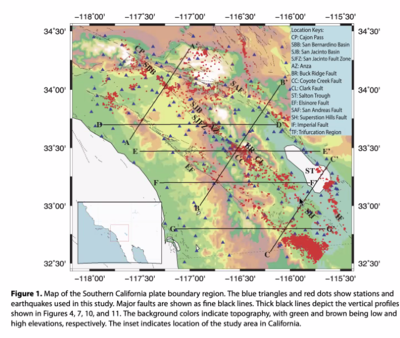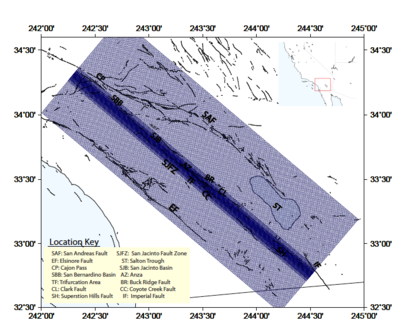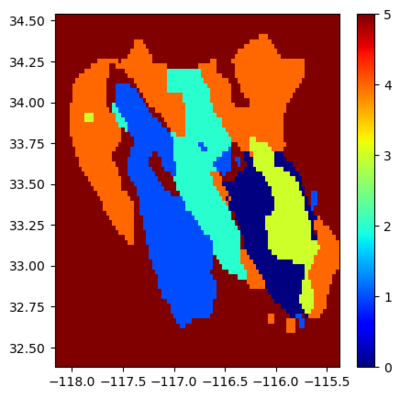Difference between revisions of "BBP Strong Ground Motion Project"
| Line 1: | Line 1: | ||
| − | == Southern California Plate Boundary Velocity Model == | + | == Southern California Plate Boundary Velocity Model (SCPBVM) == |
The Fang et al paper defines a Southern California Plate Boundary Velocity model. The max depth is 20 km; the model should be merged with a regional model to have information below that depth but it is not clear how to do this smoothly. | The Fang et al paper defines a Southern California Plate Boundary Velocity model. The max depth is 20 km; the model should be merged with a regional model to have information below that depth but it is not clear how to do this smoothly. | ||
Revision as of 20:12, 31 August 2022
Contents
Southern California Plate Boundary Velocity Model (SCPBVM)
The Fang et al paper defines a Southern California Plate Boundary Velocity model. The max depth is 20 km; the model should be merged with a regional model to have information below that depth but it is not clear how to do this smoothly.
We are looking at the Vp, Vs models of the Fang et al. (2016) pape. , and also the Fang et al. (GJI, 216, 609–620, doi: 10.1093/gji/ggy458.2019) paper that has better Vs results, and classify the results using K-means clusters as done by Eymold and Jordan (2019). We found that 6 clusters (data types) can account for most of the data. This is preliminary but can help to decide how many distinct 1D velocity models are needed for the region around the SJFZ. More work is required to decide how to merge the results with a regional model.
The model data folder has Vp, Vs, and the geographic coordinates. The format is defined as:
X1Y1Z1 X2Y1Z1 ... X1Y1Z1 X1Y2Z1 ... . . X1Y1Z2 ... . . X1YNZN ...
The horizontal grid spacing in Fang et al. (2106) has an interval of 0.03 deg in both latitude and longitude, which is about 3.3 km. The damage zones results from Allam and Ben-Zion (2012) and also Zigone et al. (2015) are included in the joint inversions of Fang et al. (2016, 2019). The image above shows the main clusters of velocity models Hao created from the Vp,Vs models of Fang et al. We are checking if the fault damage zones are already represented (if not they can be added by increasing the number of clusters).
The horizontal spacing of the nodes in the Allam and Ben-Zion 2012 is variable, starting with 100 m around the SJFZ (see brief text below and attached figure). This fine grid does not mean a resolution of 100 m around the fault, but a resolution of 1 km is a first order estimate.
The model was developed by solving for P-wave velocities (Vp) and earthquake locations on a uniform 1 km-spaced grid using a smoothed 1-D starting model (Fig. 2a) derived from Helmberger et al. (1992). The obtained velocities and event locations are then used iteratively as initial values for inversions on a variable grid that is progressively reduced to a minimum spacing of 100 m in the 4.5 km region on each side (y direction) of the SJFZ. The grid cells in the x and z directions remain uniformly spaced at 1 km. A more detailed discussion of the inversion grid and MATLAB code for generating it are included in Appendix B; a geographical location map for the grid points used is shown in Fig. S1 (above).
Prototype Web viewer for SCPBVM
This web viewer can create vertical profiles and cross section plots of the Fang et all SCPBVM.
Model Figures
| Image | Figure |
|---|---|
| SCPB Velocity Model Map | |
| Sensor Net Distribution | |
| So. Calif Velocity Regions |
Related Papers and Datasets
- Fang Southern California Plate Boundary Velocity Model (SCPBVM)
- BBP Graves and Pitarka Method
- BBP Goulet Validation Paper
- Taborda Ground Motion Paper
- Ely/Jordan Vs30 GTL Method
- Eymold/Jordan K-means Clustering Study
- Maechling BBP Software Paper
- Fang SCPBVM model data files
AGU Abstract
Evaluating the Impact of Alternative Seismic Velocity Models on Simulated Ground Motions from Large Magnitude California Earthquakes
Philip J. Maechling, Fabio Silva, Robert Graves and Yehuda Ben-Zion
Ground motion simulation methods implemented in the SCEC Broadband Platform (BBP) are designed to simulate strong ground motions at levels of engineering interest. The simulation methods have undergone extensive verification and validation efforts involving comparison of simulated results to Ground Motion Prediction Equations (GMPEs) and to the observed ground motions from historical earthquakes. The ground motion simulation methods implemented in the platform propagate seismic waves through a region-specific 1D velocity model, and typically a single 1D velocity model is selected for each validation earthquake. Recently, dense seismic arrays and other methods have produced detailed velocity models for Southern California that often resolve near surface layers better than earlier models. The goal of this study is to use the BBP with multiple 1D velocity models in a region, to study the impact of the different velocity models on the simulated ground motions. We use the Graves and Pitarka ground motion method as implemented in the BBP and large scenario earthquakes on the San Jacinto Fault and the Newport Inglewood Fault consistent with high probability UCERF3 ruptures for Southern California. Initial results in comparison with baseline ground motions using the existing BBP region-specific 1D velocity models will be presented in the meeting.


